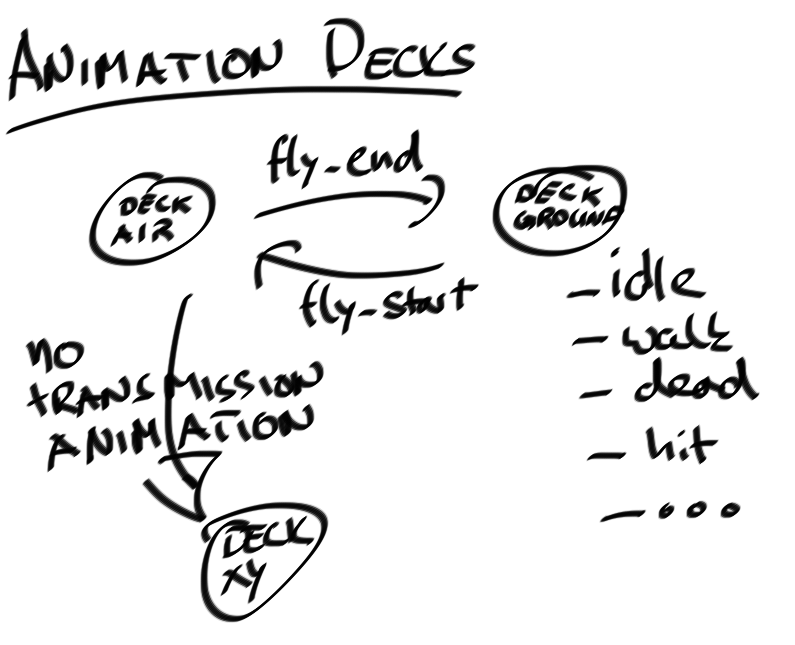Animations
Animations breathe life into models used by world objects. Here we focus on the mechanics of the internal animation system. Additionally we will discuss two important API methods that allow designers to steer the animation of characters.
Definitions
Animation label: Label describing a single animation, e.g. "walk", or "death".
Animation deck: A bundle of animations of the same position type, e.g. the "air" animation deck contains all animations a model can perform while flying. A set of standardized animations is defined for every deck (see below).
Deck transition: Transmissions between animation decks can be animated (optional). This is can for example be used to let a unit land or takeoff, when switching between the "air" and "ground" animation decks.
The Animation State Machine

The animation decks are organized in a FSM (see Figure above). A transition from one to another deck triggers the animation of labeled transition arrows.
Currently, the transition states are hardcoded (but will be exposed to the new editor, once it is available):
- ground (Default),
- air (Airborne units).
The initial animation deck state can be set in the worldObjectTemplate:
aUnit = (worldObjectTemplate "Unit") {
name: "UnitA", behavior: "A", scale: 0.3,
movementSpeed: 1, positionType: "air"
}
The following API sets a new animation deck for a specific unit
unitSetAnimationDeck(unit, newDeckName) :: undefined
Currently, we support the ground and air animation decks.
On transition from ground to air the animation with the label fly_start
(if defined) is played with a 2 seconds duration.
In the opposite direction we play the animation with the label fly_end.
Naming Conventions
Animation labels can be defined in the editor for each model. To be able to
use the animation machinery the labels have to conform to the following
guidlines.
The animation label is composed of the animation deck name its action
description (animationDeckName_actionName):
- idle (standing/Floating)
- walk (slowly moving)
- run (fast moving)
- hit (unit is hit by damage)
- death
- attack (default fallback melee attack)
- slash (single slash, sword)
- stab (quick stab, dagger)
- slam (big overhead swing, two-handed hammer)
- cast (default fallback magical spell cast)
- directed (caster facing the target, fireball)
- remote (caster not facing the target, rain of fire)
- centered (aoe spell centered around caster, group heal)
- summon (summoning/reviving a creature/minion)
- block (hiding behind a shield/weapon)
To define the idle flying animation the label air_idle has to be used in the
editor.
TODO: How do we differentiate instant cast animations from normal cast animations?
Playing custom animations
Some models may offer additional animations, e.g. the dragon model has an animation for sleeping. Designers might want to use these animations to script "mini-cutscenes". Using the following API method, the animation state of a unit can be changed:
unitSetAnimation(unit, name, duration) :: undefined
The custom animation is played for the specified duration, or looped until overridden if the duration is zero.
Note that the labels of custom animations do not follow any naming convention and do not belong to a specific animation deck.